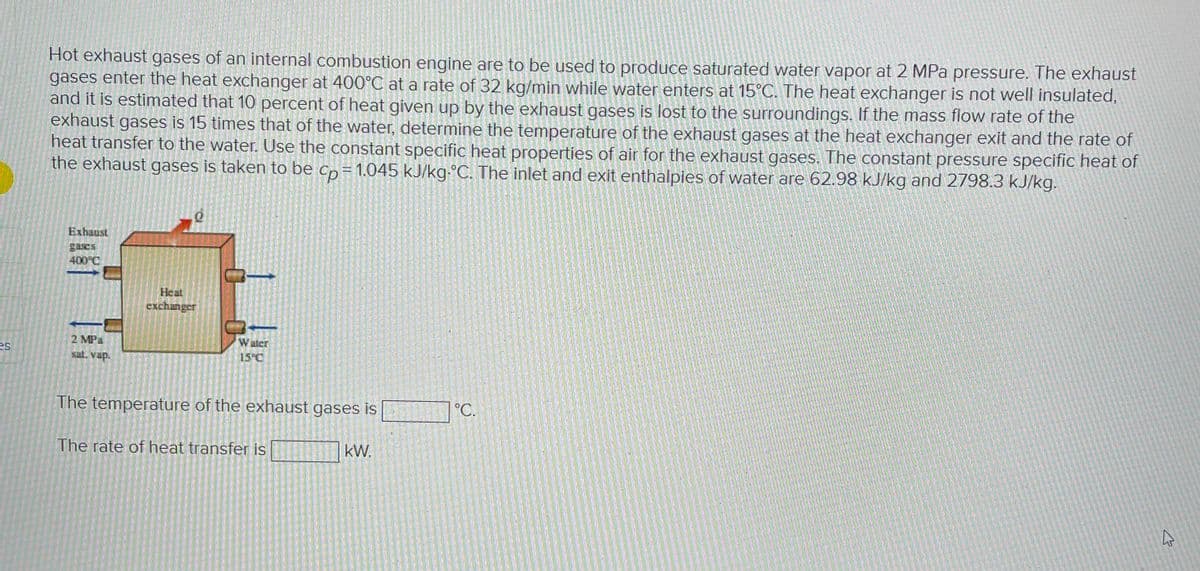Hot exhaust gases of an internal combustion engine are to be used to produce saturated water vapor at 2 MPa pressure. The exhaust gases enter the heat exchanger at 400°C at a rate of 32 kg/min while water enters at 15°C. The heat exchanger is not well insulated, and it is estimated that 10 percent of heat given up by the exhaust gases is lost to the surroundings. If the mass flow rate of the exhaust gases is 15 times that of the water, determine the temperature of the exhaust gases at the heat exchanger exit and the rate of heat transfer to the water. Use the constant specific heat properties of air for the exhaust gases. The constant pressure specific heat of the exhaust gases is taken to be cp=1.045 kJ/kg-°C. The inlet and exit enthalpies of water are 62.98 kJ/kg and 2798.3 kJ/kg. Exhaust gases 400°C 2 MPa sat. vap. Heat exchanger C Water 15°C The temperature of the exhaust gases is The rate of heat transfer is kW.
Hot exhaust gases of an internal combustion engine are to be used to produce saturated water vapor at 2 MPa pressure. The exhaust gases enter the heat exchanger at 400°C at a rate of 32 kg/min while water enters at 15°C. The heat exchanger is not well insulated, and it is estimated that 10 percent of heat given up by the exhaust gases is lost to the surroundings. If the mass flow rate of the exhaust gases is 15 times that of the water, determine the temperature of the exhaust gases at the heat exchanger exit and the rate of heat transfer to the water. Use the constant specific heat properties of air for the exhaust gases. The constant pressure specific heat of the exhaust gases is taken to be cp=1.045 kJ/kg-°C. The inlet and exit enthalpies of water are 62.98 kJ/kg and 2798.3 kJ/kg. Exhaust gases 400°C 2 MPa sat. vap. Heat exchanger C Water 15°C The temperature of the exhaust gases is The rate of heat transfer is kW.
Introduction to Chemical Engineering Thermodynamics
8th Edition
ISBN:9781259696527
Author:J.M. Smith Termodinamica en ingenieria quimica, Hendrick C Van Ness, Michael Abbott, Mark Swihart
Publisher:J.M. Smith Termodinamica en ingenieria quimica, Hendrick C Van Ness, Michael Abbott, Mark Swihart
Chapter1: Introduction
Section: Chapter Questions
Problem 1.1P
Related questions
Question
100%

Transcribed Image Text:es
Hot exhaust gases of an internal combustion engine are to be used to produce saturated water vapor at 2 MPa pressure. The exhaust
gases enter the heat exchanger at 400°C at a rate of 32 kg/min while water enters at 15°C. The heat exchanger is not well insulated,
and it is estimated that 10 percent of heat given up by the exhaust gases is lost to the surroundings. If the mass flow rate of the
exhaust gases is 15 times that of the water, determine the temperature of the exhaust gases at the heat exchanger exit and the rate of
heat transfer to the water. Use the constant specific heat properties of air for the exhaust gases. The constant pressure specific heat of
the exhaust gases is taken to be cp = 1.045 kJ/kg-°C. The inlet and exit enthalpies of water are 62.98 kJ/kg and 2798.3 kJ/kg.
Exhaust
400 C
2 MPa
sal- vap.
0
Heat
exchanger
Water
15 0
The temperature of the exhaust gases is
The rate of heat transfer is
KW.
°C.
4
Expert Solution
This question has been solved!
Explore an expertly crafted, step-by-step solution for a thorough understanding of key concepts.
This is a popular solution!
Trending now
This is a popular solution!
Step by step
Solved in 5 steps

Recommended textbooks for you

Introduction to Chemical Engineering Thermodynami…
Chemical Engineering
ISBN:
9781259696527
Author:
J.M. Smith Termodinamica en ingenieria quimica, Hendrick C Van Ness, Michael Abbott, Mark Swihart
Publisher:
McGraw-Hill Education

Elementary Principles of Chemical Processes, Bind…
Chemical Engineering
ISBN:
9781118431221
Author:
Richard M. Felder, Ronald W. Rousseau, Lisa G. Bullard
Publisher:
WILEY

Elements of Chemical Reaction Engineering (5th Ed…
Chemical Engineering
ISBN:
9780133887518
Author:
H. Scott Fogler
Publisher:
Prentice Hall

Introduction to Chemical Engineering Thermodynami…
Chemical Engineering
ISBN:
9781259696527
Author:
J.M. Smith Termodinamica en ingenieria quimica, Hendrick C Van Ness, Michael Abbott, Mark Swihart
Publisher:
McGraw-Hill Education

Elementary Principles of Chemical Processes, Bind…
Chemical Engineering
ISBN:
9781118431221
Author:
Richard M. Felder, Ronald W. Rousseau, Lisa G. Bullard
Publisher:
WILEY

Elements of Chemical Reaction Engineering (5th Ed…
Chemical Engineering
ISBN:
9780133887518
Author:
H. Scott Fogler
Publisher:
Prentice Hall


Industrial Plastics: Theory and Applications
Chemical Engineering
ISBN:
9781285061238
Author:
Lokensgard, Erik
Publisher:
Delmar Cengage Learning

Unit Operations of Chemical Engineering
Chemical Engineering
ISBN:
9780072848236
Author:
Warren McCabe, Julian C. Smith, Peter Harriott
Publisher:
McGraw-Hill Companies, The